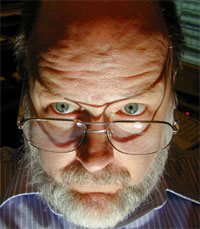Yesterday's high tech is today's humor
Remember how you lusted after one of those blazingly fast 386 computers with 2MB of RAM and a huge 40MB hard drive? So do I. The trouble with high tech devices is that they remain high tech for about 3 nanoseconds. After that, we laugh at them.
In December of last year, I put together a forward-looking presentation for the Columbus Computer Society and the Licking County Computer Society. While doing some of the research, I ran across some pictures of older computers and some technology that pre-dated computers. I was fascinated and used some of that information to open the presentation.
Note: Dates are as accurate as I could make them. I was able to corroborate some of the information, but not all. This article was written essentially as a nostalgic memory dump and should not be considered to be absolutely accurate. Some of the images shown are from other websites that deal with the history of computing. When I started collecting the images, I didn't have plans to use them in a retrospective and I didn't record the URLs from which they came.
 |
 |
|
Uh-oh. I set the time machine too far in the past.
I do seem to own one of these, though. |
 |
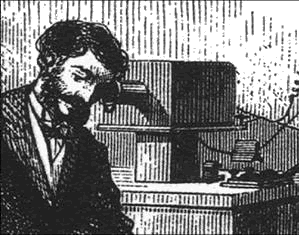 |
|
High tech may have started with the telegraph. Western Union thought the telephone would be a failure and wasn’t interested in acquiring Bell’s invention.
I do not own one of these, but I do have a phone with a rotary dial down in the basement. |
 |
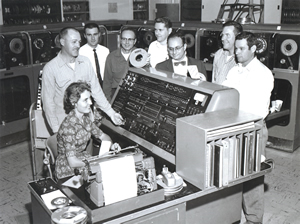 |
|
UNIVAC grew out of efforts in World War II. The average handheld computer has far more power than this room-size monstrosity.
It required so many operators because the machine (in a cabinet 50 feet by 30 feet) contained 18,000 tubes and every time the operators started the machine, they were assured that some of the tubes would fail.
Today's computers have the equivalent of millions of tubes on a single piece of silicon.
I do not own one of these. |
 |
 |
|
Admiral Grace Hopper developed the programming language COBOL (COmmon Business Oriented Language) and one member of her group found the first real computer bug, a moth that had caused a short circuit.
That's the moth, taped to the log sheet.
I do not own one of these. |
 |
 |
|
The people who designed early computers used slide rules. Eventually, slide rules were replaced by pocket calculators.
Yes, I own one of these. Ah, make that two. Once I almost understood how to use them. |
 |
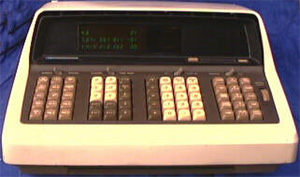 |
|
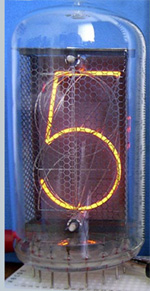 Desktop calculators cost thousands of dollars and were bolted to tables. That was unnecessary because many of them relied on electronics in a big box that was bolted to the underside of the table and connected to the display on the table with a large cable. Desktop calculators cost thousands of dollars and were bolted to tables. That was unnecessary because many of them relied on electronics in a big box that was bolted to the underside of the table and connected to the display on the table with a large cable.
These usually relied on nixie tubes for the display. That's a nixie at the right.
I did not own one of these. |
 |
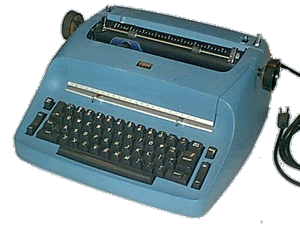 |
|
IBM developed the Selectric typewriter and later sold the division when personal computers began to take over. More recently, IBM has sold a large part of its personal computer business to a company in China.
I *DO* own one of these. |
 |
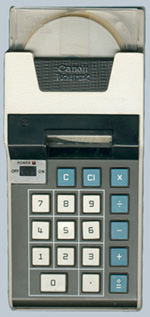 |
|
Canon introduced the Pocketronic "hand-held" calculator in 1970. It cost $400 and offered the ability to add, subtract, multiply, and divide. No percent. No inverse. No square root. No programming. Just four functions. It did have a built-in printer (thermal paper) and ran on integrated circuits from Texas Instruments.
It might have fit into Captain Kanagroo's pocket, but not into a regular person's pocket.
I didn't own one of these, but I was delighted, a few years later, when I proved how intelligent I was by waiting for the price to come down. I bought a 4-function calculator with percent function and square roots (and even a memory register) for just $90. A few years later, Radio Shack was selling much more powerful models for $9. |
 |
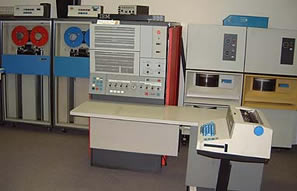 |
|
The IBM 360 was the pinnacle of power. I remember ...
- Writing programs on card-punch machines.
- Submitting programs that should generate 50 pages of output and getting back a single page with an error code.
- Handing card decks to the computer operator who dropped them into the card reader, and sometimes dropped them onto the floor.
- Two words: SNOBOL & WATFIV
I do not own one of these. |
 |
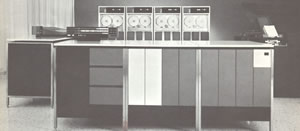 |
|
Honeywell 200. Each of those dark vertical cabinets contains core memory – all of 64K per compartment. Today I carry around 500,000K in a device that's smaller than a pen.
I do not own one of these,
although I work in a building where one used to live. |
 |
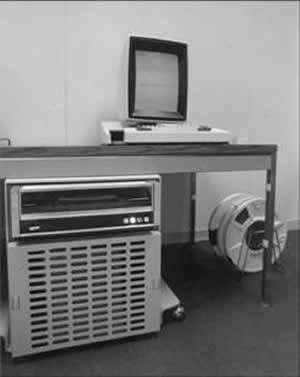 |
|
During the late 1960s, the Xerox Palo Alto Research Center began working on the ALTO “desktop” computer. PARC invented the GUI, the mouse, much of the technology used by the Internet.
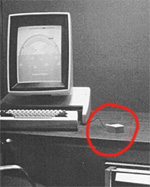 Note the rectangular (wooden) "mouse" at the right of the keyboard. You'll see it again soon. Note the rectangular (wooden) "mouse" at the right of the keyboard. You'll see it again soon.
I do not own one of these. |
 |
 |
|
The Apple 1 was introduced in 1976 and sold for $666.66. It came with 4K of RAM and, yes, this is the whole computer. It was just a circuit board with an MOS 6502 CPU running at 1.0MHz.
I did not own one of these. |
 |
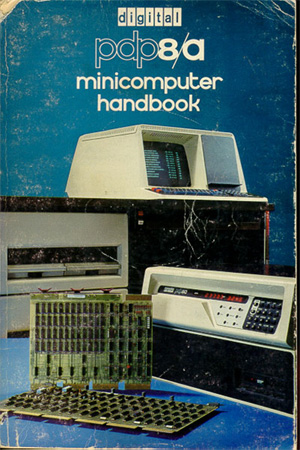 |
|
Digital Equipment Corporation (DEC) proved that it was possible to make a smaller computer that could be used by companies that were too small to afford mainframe computers.
I didn't own one of these, but I worked in a building with a lot of DEC's later models, the PDP 11/70. A PDP/8 sat in the office of one of the vice presidents until he retired and the machine was hauled out to the trash. |
 |
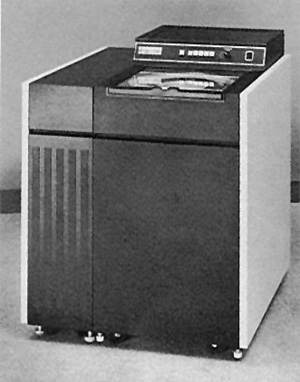 |
|
Disk drives (big ones were 40MB) were still the size of washing machines. The platters were removable.
I didn't own one of these. |
 |
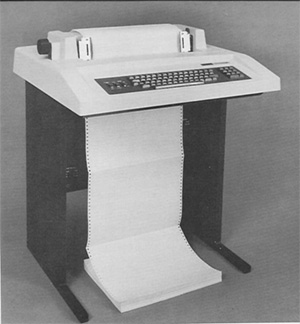 |
|
And printers filled a substantial part of the room. This is a DEC LA36 printing terminal.
I didn't own one of these, but we had several LA120 printing terminals around the building. |
 |
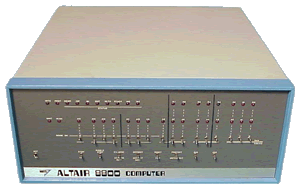 |
|
ALTAIR changed everything when it developed a computer kit that made the cover of Popular Electronics in January of 1975. Why Popular Electronics instead of a computer magazine? There were no computer magazines in 1975.
I do not own one of these, but I wanted one at the time.
Thanks to Colin Campbell for finding an error. I had attributed this article to Popular Mechanix. |
 |
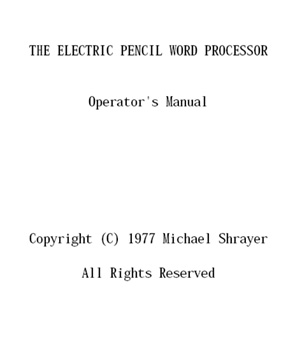 |
|
Electric Pencil, the first word processor. The manual (such as it was) had no illustrations.
I owned a copy of this when it was ported to the IBM PC in the 1980s. |
 |
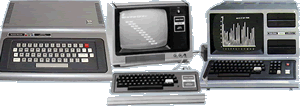 |
|
Tandy got into the game with Radio Shack TRS80 computers. Remember when floppy disks were 8 inches across, single-sided, and held less than 200K of data?
I do not own one of these. |
 |
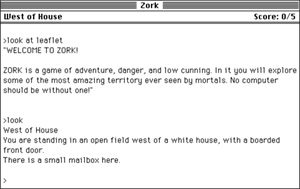 |
|
I played Zork on the office minicomputer (it would run only after hours), on the Atari, and later on a Zenith PC. It was a game in which the graphics were all in your mind – rather like reading an interactive book.
By the way, Zork 1, Zork 2, and Zork 3 are available for FREE (legally) here. Both Windows (DOS) and Mac versions are available and yes, you can play on Mac OS X.
I *DO* own one of these. More than one, actually – a copy for the Atari and another for MS DOS. |
 |
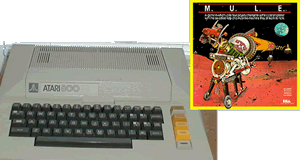 |
|
Atari, Sinclair, and several others brought computing into the home. M.U.L.E. was one of our favorite games and we still have a working Atari 800 with a working copy of M.U.L.E.
I *DO* own one of these and it still works. |
 |
 |
|
Speaking of Sinclair, the ZX80 showed up in early 1980 for $200. The company sold nearly 100,000 of the 12-ounce computers with 1K of RAM (expandable to 64K) and a Z80 CPU running at 3.25MHz.
I do not own one of these. |
 |
 |
|
The monitor on the original Apple ][ left a little to be desired, but these machines started showing up in offices so that they could be used to run VisiCalc.
I do not own one of these. |
 |
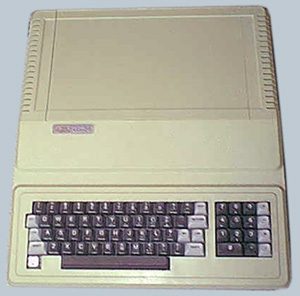 |
|
Not long after the Apple ][ started shipping, the Agatha became available in the U.S.S.R. This was, of course, just a coincidence.
I did not own one of these. The FBI was already tapping my phone in those days and I didn't need to give them any additional enticements. |
 |
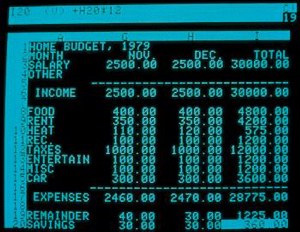 |
|
VisiCalc on an Apple. It was later ported to the IBM PC and eventually killed by Lotus 1-2-3, which was essentially eliminated by Excel. What was Microsoft's first spreadsheet program? You'll see it later.
My first spreadsheet was Lotus 1-2-3. |
 |
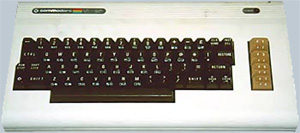 |
|
Commodore released the VIC 20 in 1980. Colorful graphics and low cost made the VIC-20 an immediate success. Commodore, at one time, was making 9000 units per day. This was the first color computer to sell for less than $300.
I never owned a VIC 20. In those days, my eyes were on Atari. |
 |
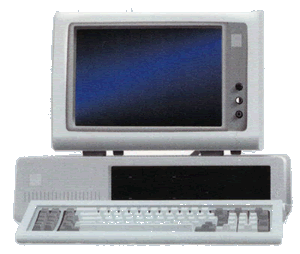 |
|
IBM entered the PC market with an open system in 1981. IBM in early December 2004 announced that it is selling off the PC division of the business.
I never owned an IBM PC. |
 |
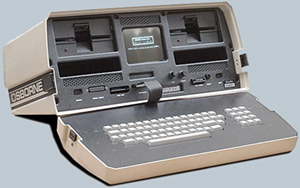 |
|
Portable computers were a lot like early portable televisions. The only way you knew they were portable was because they came with a handle. The Osborne 1 weighed in at 25 pounds.
Introduced in April 1981 at $1800, the Osborne 1 was popular because it had a blazingly fast Zilog Z80 (4.0MHz) process and an amazing 64K of RAM. The built-in 5" monitor displayed 53 characters across and 24 lines. It ran CP/M.
Osborne made a small marketing blunder. In 1982, the Osborne Computer Company announced a successor machine and then announced plans to make an MS-DOS compatible portable. This caused potential customers to stop buying the Osborne 1 and they were unable to buy the newer models because they were still in development. The company filed for bankruptcy in September of 1983. Oops.
I did not own one of these . |
 |
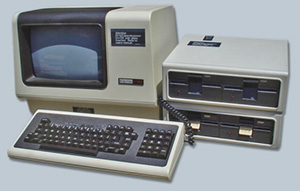 |
|
You won't find many DEC Robin computers. They were essentially oversized VT100 terminals with a computer motherboard inside the CRT case. The keyboard and floppy drives were separate. The unit pictured has 4 floppy drives and is therefore a "super PC". DEC made these available only to employees.
Needless to say, I did not own one of these. |
 |
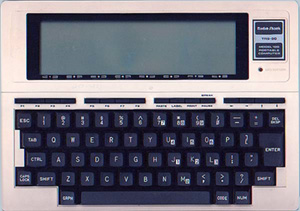 |
|
In the late 1970s, Radio Shack began shipping the first real "laptop" computer and it became an immediate hit with journalists because it had a built-in modem and ran forever on battery power.
The computer made in Japan by Kyocera and all of the ROM-based programs (text editor, telecommunications program, BASIC) were by Microsoft and some reportedly were written by Bill Gates.
The built-in modem was, of course, a 300-baud device, which was standard at the time.
I didn't own one of these, but I did have a British version that was a bit smaller and had a goofy membrane keyboard. |
 |
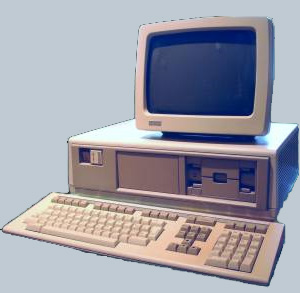 |
|
DEC started shipping the Rainbow 100 in 1982. It was one of the first dual-processor machines. It ran CP/M on a Zilog Z80 CPU and DOS on an Intel 8088 CPU. It could also boot in terminal mode and operate as a VT100.
DEC's engineers saved space by using a single drive assembly that could accept two disks.
I did not own one of these. |
 |
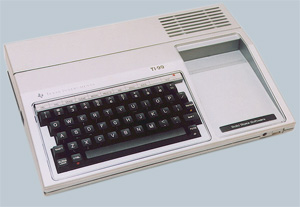 |
|
From 1979 to 1984, the TI 99/4a developed a following. The TI could accept up to 7 peripherals. It came with 16K of RAM (a 32K RAM extension was available) and its TI TMS 9900 CPU ran a 3.3MHz. (Some of today's computers run at 3.3GHz.)
I do not own one of these. |
 |
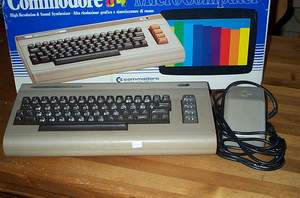 |
|
In 1982, the Commodore 64 was one of the three most popular computers (the other two were the Apple II and the Atari XL). Commodore was at the top of the list with sales of 30,000,000 units.
The C64 was an up-scale version of the VIC-20.
I don't own one of these, either. |
 |
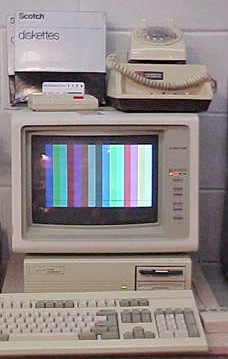 |
|
Bring in the clones!
Suddenly, everyone was making "IBM compatible" computers, which meant using Intel processors and carefully cloning even the errors in the firmware.
Zenith computers were also available in kit form with the name "Heathkit" on the case.
I did own a Zenith and upgraded it to (WOW!) 320KB of RAM. I also added a hard disk (external) and, later an internal hard disk. Then I bought a faster processor and added a big fan to keep it cool. Zenith designed computers with a "backplane" so the motherboard plugged in the way add-on boards plug in today. |
 |
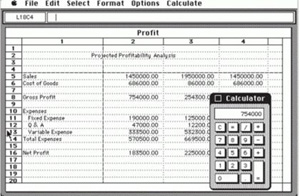 |
|
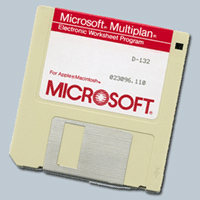 Think Excel was Microsoft's first spreadsheet program? Nope. The first was Microsoft Multiplan, shown here running on a Mac. Think Excel was Microsoft's first spreadsheet program? Nope. The first was Microsoft Multiplan, shown here running on a Mac.
I had a copy at the office, but not for a Mac. Therefore, this is not my disc. |
 |
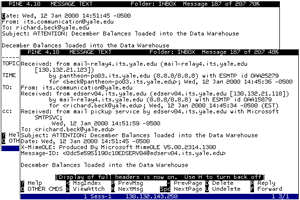 |
|
Wow! Those of us who worked in an office with an Internet connection could send e-mail with PINE! Remember when it was exciting to receive e-mail?
My office had a dedicated 56K modem connection that served about 20 people on our office network for $100/month and phone costs.
PINE is available for PCs. It is still commonly used on Unix systems. |
 |
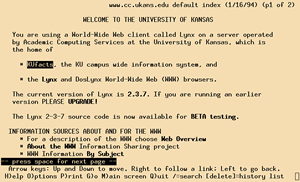 |
|
Tim Berners-Lee invented the Web in his spare time in Switzerland. His boss allowed him to work on the project at the particle acceleration lab because he thought there might be some promise in Berners-Lee's idea.
Initially, the Web was text only.
If you want to see the Web the way it was, download and install a copy of Lynx. It's free. |
 |
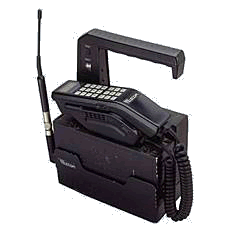 |
|
The first cell phone arrived at the WTVN newsroom in the mid 1980s.
I took one look at that bulky, heavy phone and said something like this. "Look, those may catch on in Los Angeles, where people spend a lot of time in cars, but who would ever want one in Columbus?"
I *DO* own one of these. Well, not one like this. This is an antique analog phone. The one I own is smaller than the handset shown here and includes a full QWERTY keyboard. |
 |
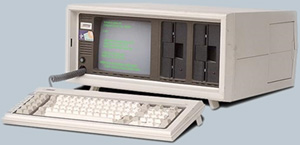 |
|
The 1982 introduction of the Compaq portable computer (28 pounds and still not all that portable) defined "IBM compatible" and was a model of rugged construction.
I didn't own one of these, but I took some apart and found the construction to be extraordinary. |
 |
 |
|
In 1983,toy maker Coleco announced the Adam at the summer Consumer Electronics Show. The Z80-based computer came with an 80-column daisy wheel printer and two game controllers for $600. It was compatible with ColecoVision games, but the company had tried to put too many pieces in a single box. The result was a failure-prone computer that, because of an excellent advertising campaign, flew off store shelves but then flew right back to the returns counter.
Coleco, the name was an acronym formed from Connecticut Leather Company, went into bankruptcy in 1984 in part because of Adam and in part due to inept handling of the Cabbage Patch Kids fad.
I do know someone who bought one of these. And returned it. |
 |
 |
|
Apple released the Lisa computer in 1983, which was too expensive ($10,000!) to reach a mass audience. While it was ahead of its time in many ways, it's probably one of the reasons Apple developed its reputation for selling only expensive computers.
Remember that square mouse from the Xerox Palo Alto Research Center? Apple likes to claim that nothing from PARC influenced them in any way, but it's interesting to note that PARC had working models of the mouse, the graphical user interface, and a desktop computer well before Apple "invented" the PC.
I do not own one of these, but I do like its great-great-great grandson, a G4 PowerBook. |
 |
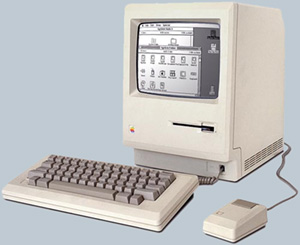 |
|
A year later, Apple created a sensation during the Super Bowl that wasn't matched for 20 years and wouldn't have been matched then, but for a "wardrobe malfunction".
The original Mac was pitifully slow and Apple was still using that squared-off single-button mouse they borrowed from PARC. Today's Apple mice are rounder, but they still haven't deviated from PARC's original 1-button specification. (Actually, this is wrong. Skip forward to 2013 for a correction.)
For $2500, buyers got a Motorola 68000 CPU running at 7.83 Mhz, 128K of
RAM (later models increased that to 512K). The Mac came with a 9-inch monochrome screen and a 400K single-sided (double density) floppy. You could buy an external floppy drive if you had a lot of data to store. It sold for $500.
I did not own one of these. |
 |
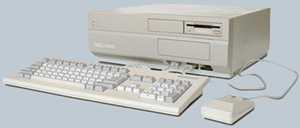 |
|
The Amiga was an amazing machine from Commodore and, despite its early demise, it had ardent supporters for years, in part because it included "autoconfiguration", a feature that Apple and Microsoft didn't get right for a long time. And it handled graphics better than any other machine available at the time.
I did not own one of these. |
 |
 |
|
GEM was a graphical user interface (GUI) from Digital Research. It gave PCs a Mac-like interface. The GEM GUI was called a WIMP (an acronym for windows, icons, menus, and pointing device) and was one of several types of GUIs being investigated at the time.
The creator of GEM had recently left Xerox PARC. GEM was an early winner with ports for Atari, PC/DOS machines, Amstrad, and others.
GEM was demoed at the 1983 COMDEX show and shipped in the spring of 1984. Digital Research defeated itself by not recognizing the potential of the GUI and not marketing it well. GEM 3 was the final version of the operating environment and was replaced by Windows. The Atari version continued to be developed until the early 1990s.
GEM had drawing, painting, and publishing applications. The best known publishing application was Ventura Publisher, which was soon acquired by Xerox and mismanaged to near oblivion.
Ventura is now owned by Corel and appears not to be being developed.
I began using Ventura Publisher with version 1 and, therefore, had many computers over the years that ran GEM. It was a better operating environment than early versions of Windows, but DR didn't continue to develop its operating system and Microsoft began to improve Windows incrementally.
Side note
The head of Digital Research was Gary Kildall. When IBM wanted to talk with Kildall about using his company's operating system for the soon-to-be-released IBM PC, Kildall was unable to meet with IBM's representatives. (The, perhaps apocryphal, story is that he wanted to go sky-diving that day and wasn't about to be inconvenienced by IBM.) IBM went to Bill Gates. DR eventually went broke. Gary Kildall died in early 1995 from complications following a bar fight. |
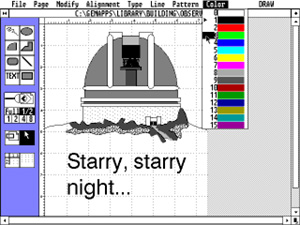 |
|
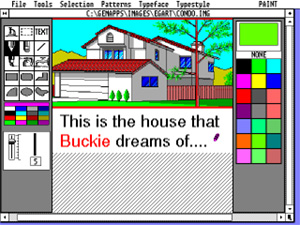 |
|
 |
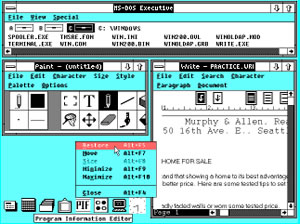 |
|
Windows version 1, an idea borrowed from Apple based on an idea borrowed from Xerox PARC.
I avoided this version of Windows, and version 2 of Windows. When applications began requiring Windows, I grudgingly accepted the change. |
 |
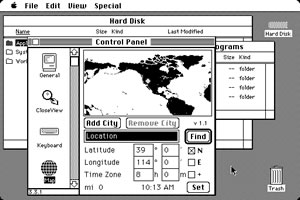 |
|
Mac System 6 - 1988
I never used an Apple operating system until OS X was released. The Ibook I purchased came with System 9 and OS X. I remember being appalled by the shortcomings of System 9. The supposedly "better" operating system had no real memory management, no true multi-tasking, and no multi-threading. All that arrived with OS X, about 6 years behind Microsoft's operating systems. |
 |
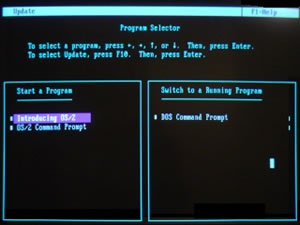 |
|
IBM and Microsoft worked together on OS/2, but then Microsoft decided to pursue Windows instead. OS/2 was somewhat more stable and robust than early versions of Windows, but Microsoft won the marketing war.
-
OS/2 v.1 – 1987
-
OS/2 v.2 – 1992
- OS/2 v.3 Warp - 1995
Oh, yes, I remember this. |
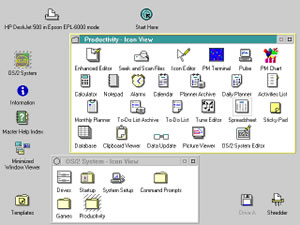 |
|
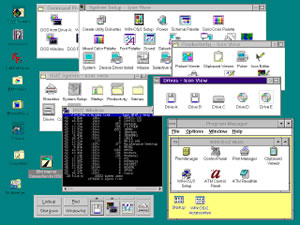 |
|
 |
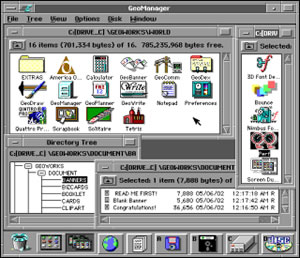 |
|
How about GeoWorks? The image at the left is from a 1991 version of the application for MS DOS machines, but it was originally developed for the Commodore C64 in 1986. It became available to Apple users in 1988 and to those with Intel-powered computers in 1989.
We used GeoWorks at the office for some specialized applications. |
 |
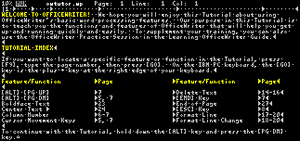 |
|
WordStar knocked off Electric Pencil. WordPerfect knocked off WordStar. Word knocked off WordPerfect.
WordStar and WordPerfect are now both owned by Corel.
WordPerfect 5.1 for DOS may be the best word processor ever made, but it didn't have a graphical user interface. |
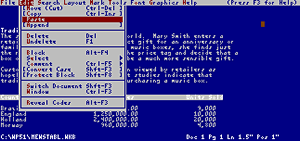 |
|
 |
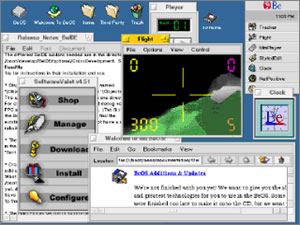 |
|
Be OS – 1999. This was the operating system with an attitude. It didn't sell well. Palm bought it, thinking that it might be an option for handheld devices, but never followed through.
BeOS is now sitting on a shelf somewhere in San Diego.
I do not own one of these. |
 |
 |
|
The shrinking floppy. 8 inches, then 5.5 inches, then 3.25 inches, and now all but extinct.
For several years I had machines with both 5.5 and 3.25 inch drives. |
 |
The photo annex |
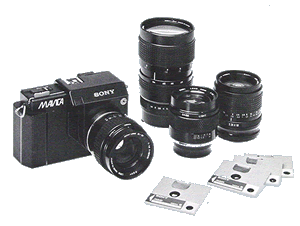 |
|
1981 Sony Mavica – the first digital camera with a picture 570px by 490px using NTSC (television) technology. Mavica was an acronym formed from magnetic video camera.
I do not own one of these. |
 |
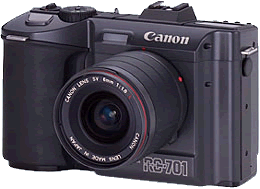 |
|
1986 - The Canon RC-701 was aimed mainly at the press market. It had four dedicated interchangeable lenses and also offered an adapter for 35mm lenses. Price of the RC (RC stood for Realtime Camera) with an 11-66mm f/1.2 lens was about $3,000. The complete RC-701 system consisting of the camera, a player/recorder, a printer, a laminator, and a unit for phone transmission cost about $27,000. The CCD was 6.6mm x 8.8mm with 187,200 pixels.
I do not own one of these. |
 |
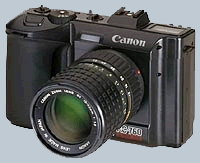 |
|
1987 - Canon RC-760 Still video camera.
USA Today started using these 600,000 pixel cameras to cover special events. Editors could see images on their computers 12 minutes after they were taken. These cameras cost $5,500.
I do not own one of these. |
 |
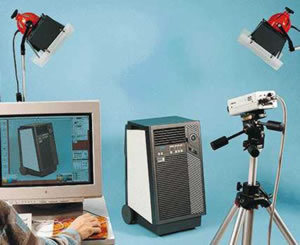 |
|
In 1991 - Cross Celsis-130 and 160. Resolution had now reached the astronomical size of 1,280 x 960 pixels (for about $20,000) or 3072 x 2320 pixels if you had a budget of $30,000. The cameras had 3 CCDs (1 for each color) and had to be mounted on a tripod.
Oh, and by the way, in 1990 Adobe started shipping Photoshop. It was a Mac-only program and had no color management.
I definitely do not own one of these. |
 |
I'm not alone in finding these machines interesting
Today's computers are beige (or, occasionally, black) boxes that come in two primary flavors: Windows and Mac. In the early days, every manufacturer has an idea about how to make things work better. The machines had a certain amount of personality. I started working on this report last December and shared the early versions with some acquaintances. One of those is Pete Gaughan, an editor at Sybex.
 Pete sent two books he thought I'd find interesting and he was correct. Digital Retro by Gordon Laing is a fascinating trip back in time – not quite all the way to the abacus. The book includes some astonishingly good photographs of vintage computers and in-depth descriptions of the machines. The book starts with the original Apple and, in a little less than 200 pages, covers the development of personal computers through 1990. Pete sent two books he thought I'd find interesting and he was correct. Digital Retro by Gordon Laing is a fascinating trip back in time – not quite all the way to the abacus. The book includes some astonishingly good photographs of vintage computers and in-depth descriptions of the machines. The book starts with the original Apple and, in a little less than 200 pages, covers the development of personal computers through 1990.
This is a $30 book on high-quality paper. If you lived through this period and remember the Commodore Pet, Apple's Lisa, the Oric-1, Coleco, Osborne, Sinclair, Tatung, Atari, and Amstrad, this is a book you'll want to have in your library.
It's the kind of book that brings back memories of carefully opening the case of a Zenith computer and adding 9 additional chips (parity was important in those days) to expand the system from 256 KILObytes of memory to 320 KILObytes. When I put the cover back on and started the computer, it worked. I was amazed.
More information on this book.
Pimp your computer
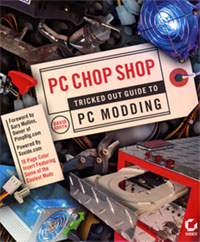 The second book Pete sent is David Groth's PC Chop Shop Tricked Out Guide to PC Modding and it's about as far from Laing's book as is possible. Groth explains (and shows) how to convert a plain vanilla PC to something people will write home about. The second book Pete sent is David Groth's PC Chop Shop Tricked Out Guide to PC Modding and it's about as far from Laing's book as is possible. Groth explains (and shows) how to convert a plain vanilla PC to something people will write home about.
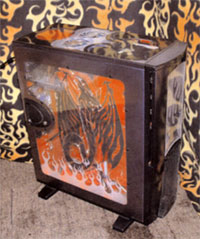 Much of the book describes how to modify the computer's case, but it also gets into some dangerous areas. To Groth's credit, he's careful to point out that overclocking your computer's CPU and RAM can cause the system to become unstable or to suffer a catastrophic hardware failure. Much of the book describes how to modify the computer's case, but it also gets into some dangerous areas. To Groth's credit, he's careful to point out that overclocking your computer's CPU and RAM can cause the system to become unstable or to suffer a catastrophic hardware failure.
This is not a book for the timid, but you'll love it if you're the kind of person who wants to wring the last possible bit of performance out of your computer and you're willing to take some risks. Even if you're conservative about the hardware, you'll learn now to tinker with the case and turn it into something that will stand out from the usual box.
More information on this book.
Technology corner rating for Digital Retro |
 TEN CATS: This is one of the most entertaining books I've read lately. I'd forgotten about some of those early machines from the days when computers actually had personalities. TEN CATS: This is one of the most entertaining books I've read lately. I'd forgotten about some of those early machines from the days when computers actually had personalities. |
| How the Technology Corner rating system works. |
Technology corner rating for PC Chop Shop Tricked Out Guide to PC Modding |
 EIGHT CATS: I wouldn't have bought this book on my own because I don't care much what the computer looks like. A mismatched panel on a component doesn't bother me, for example. But if I wanted to upgrade a machine with a radical make-over, this is where I'd turn. EIGHT CATS: I wouldn't have bought this book on my own because I don't care much what the computer looks like. A mismatched panel on a component doesn't bother me, for example. But if I wanted to upgrade a machine with a radical make-over, this is where I'd turn. |
| How the Technology Corner rating system works. |
NTI burns CDs and DVDs, edits audio, and handles almost everything
NTI CD & DVD Maker burns CDs and DVDs. Nothing unusual there, but the user interface is one of the faster and easier ones I've seen. The program also helps you to organize and share files. And there's a backup function if you want to backup data to CDs or DVDs.
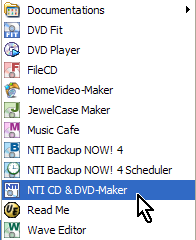 The application includes just about every feature you might want. The application includes just about every feature you might want.
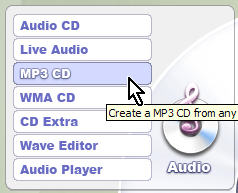 DVD Fit is a new feature that compresses dual-layer movies to fit on single-layer DVDs by removing unwanted features. NTI would like me to mention that this will not work with copy-protected movies. Disc spanning lets you archive data files on CDs and DVDs -- and "Cinematic Video" and "Cinematic Slideshow" functions let you share home videos and slideshows, including some useful transitions and effects. DVD Fit is a new feature that compresses dual-layer movies to fit on single-layer DVDs by removing unwanted features. NTI would like me to mention that this will not work with copy-protected movies. Disc spanning lets you archive data files on CDs and DVDs -- and "Cinematic Video" and "Cinematic Slideshow" functions let you share home videos and slideshows, including some useful transitions and effects.
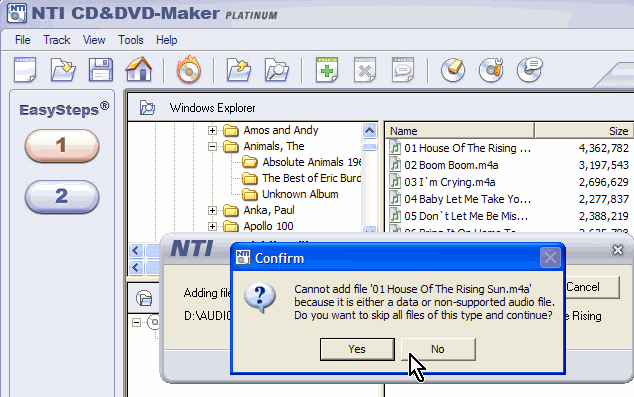
Despite the fact that Apple has used the MP4 format (which Apple calls AAC) for quite some time, most applications still don't support the format. That includes NTI CD & DVD Maker.
To share photos, you'll want to use the Photo Disc feature to save JPEG images on a CD in a manner that makes them playable in many new DVD players.
NTI CD & DVD Maker includes support for dual-layer DVD media.
I spoke with Ray McGoldrick, NTI's Product Manager for NTI CD & DVD Maker about the functionality ... starting with what NTI offers to Mac users ...
REAL AUDIO 3:55 q-truly safe now.
Technology corner rating for NTI CD & DVD Maker |
 EIGHT CATS: I really with that this application could deal with MP4 (AAC) files. Except for that shortcoming, it's an excellent choice for those who want a unified approach to audio and video files on CDs and DVDs. EIGHT CATS: I really with that this application could deal with MP4 (AAC) files. Except for that shortcoming, it's an excellent choice for those who want a unified approach to audio and video files on CDs and DVDs. |
| How the Technology Corner rating system works. |
Nerdly News
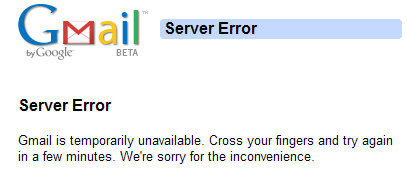 G-oops-gle G-oops-gle
I noticed an odd problem with GMail (Google's e-mail system) on Thursday. This is something I haven't seen before and it didn't last long on Thursday, but there it was -- server outage.
Maybe this is why it's still officially in Beta even though it's been stable for a long time and is far better than any other Web-based e-mail.
GMail must be close to being released. Subscribers now have 50 invitations to offer -- and when you use the 50, you get 50 more. If you want a GMail invitation, let me know and I'll send one along.
Microsoft back-pedals on a new browser
The next version of Windows will have a fully integrated browser. Unlike Internet Explorer, which Microsoft claimed was fully integrated into the operating system but wasn't, the version in Longhorn (due out sometime before the next Ice Age) will be fully integrated. Until this week, Microsoft had maintained that there would be no new version of IE prior to Longhorn.
But the continuing series of worms, viruses, spies, and annoyances that depend on IE's shortcomings -- coupled with the advent of a competent browser that doesn't have these shortcomings -- has caused enough users to defect that it got the attention of somebody in Redmond. Firefox, the open-source browser from the Mozilla organization, has seen its market share increase dramatically and Microsoft has seen a slight dip in usage. Firefox is still shy of 10% market penetration and IE is still above 90%, but the trend is such that -- if continued -- Firefox could do to IE what IE did to Netscape.
So -- SURPRISE! -- Microsoft now says that we'll see a new version of the browser later this year -- July or August probably.
And the new browser will work only with Windows XP. Not Windows 2000. Not Windows NT. Not Windows Me. Not Windows 98 -- not even the second edition. Not Windows 95. Certainly not Windows 3 or earlier. That's probably going to cause no small amount of whining and may even push some IE users over to Firefox, but let's face it --
- Windows 95 was released a decade ago and had no security features.
- Windows 98 is an antique as software goes and had virtually no security features.
- Windows NT had some security features, but the technology is dated.
- Windows 2000 improved on Windows NT's support for devices, but not on security.
- Windows Me was probably the company worst operating system.
- Windows XP is the first version of Windows with any real security features and support for today's hardware.
So -- like it or not -- Microsoft is making the right decision by ignoring the antiques. It's as illogical for those who run older operating systems to expect continuing upgrades and patches as it is for people who have slow Internet connections to expect website developers to avoid all modern techniques so that the sites will display quickly on dial-up lines. Life isn't always fair and companies have to go where their customers are.
As of January, 64% of Internet users are running Windows XP. Surprisingly 14% are still using Windows 98 and 13% still have Windows 2000, compared to 2% on Macs and 1% with Windows NT. These are figures from TheCounter.com, an organization that tracks usage at thousands of websites.
Let us know what you think. Write to:
Bill Blinn --
Joe Bradley --
 |
Have a question? Ask it and you might pick up a prize for stumping the chump.
Send your question to .
And ... good luck! |
|





